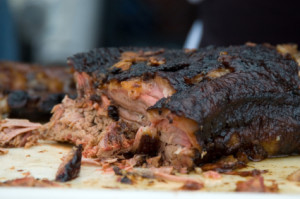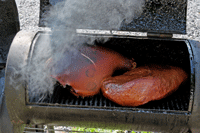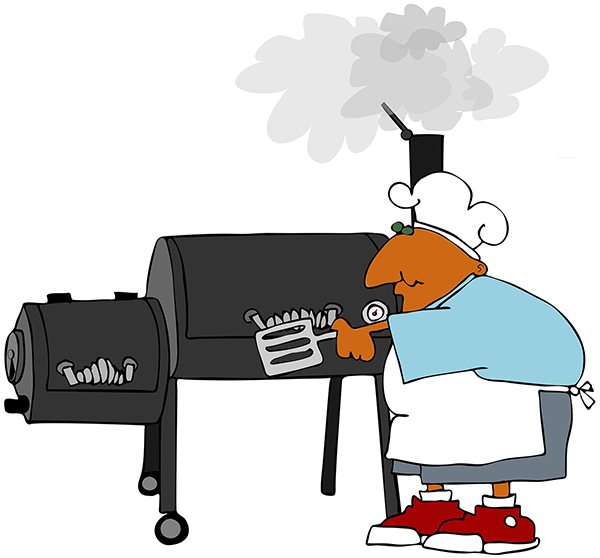Learn How to Barbeque Brisket and Show Off Your Skill with the Smoker
 What is barbeque brisket? Barbeque brisket is another regional specialty of barbeque, originating in Texas and currently found in most barbeque establishments. After ribs, it’s probably the most popular barbeque choice. It’s a great alternative to pork barbeque.
What is barbeque brisket? Barbeque brisket is another regional specialty of barbeque, originating in Texas and currently found in most barbeque establishments. After ribs, it’s probably the most popular barbeque choice. It’s a great alternative to pork barbeque.
Brisket is a beef cut found on the breast behind the foreshank. It’s loaded with connective tissue which means there is a significant amount of collagen in the meat. (translation…it’s tough)
Brisket is a tough but flavorful cut of beef, therefore, it’s perfect for “low and slow” barbeque cooking. When you purchase your beef look for “choice” grade certified Angus beef. We think it is a waste to spend money on “prime” graded cuts (unless you graduate to competition barbeque) because your barbeque cooking method will render it very tender.
The upside is that the new cook will find that the general steps for cooking are pretty much the same for barbeque brisket as for pork shoulder and relatively easy but, as stated before, it does take patience.
Let’s get started on the specific cooking steps:
- The first thing you want to do is to clean and pat the brisket dry.
- Next trim the fat cap, if desired.
Some cooks trim fat from the brisket but it’s not really necessary unless you just want your meat to look pretty. The fat actually prevents it from completely drying out.
I also think the fat really helps the flavor. Remember that you are using a smoker, which means you are generally placing your brisket on a rack or grid.
Plus it’s always a good idea to place a drip pan under your meat. The drippings can be used to make a sauce for serving the barbeque.
- Season your brisket.
There are many spice combinations that produce a pretty good barbecue brisket. We believe, however, that there are some predominant spices that go very well with brisket.
They include onion powder, garlic powder, black pepper, smoked paprika, salt, sugar, dry thyme, dry mustard and cayenne. Check out the some of these barbeque brisket rub recipes.
As stated with the “Pork Barbeque” steps, injection marinades are an additional step that can be used as flavor enhancers. Beef injection marinades generally have different ingredients than those used for pork.
There are also many good recipes for marinade. We use a mixture of beer, onion powder, garlic salt, Worcestershire sauce, and Dr. Pepper. I know, it’s a little weird but it makes a tasty brisket.
Now that you have your spices on the meat you must let it marinate. A simple sealable plastic container works very well for marinating. Marinate in the refrigerator for at least 2 hours but preferably 24.
We’ve recently switched to using our FoodSaver machine for marinating. If you are not familiar with these machines they allow the home user to vacuum seal food for refrigeration and freezing. It does a great job of marinating because vacuum sealing the seasoned meat seems to force more of the marinade to soak in.
- Once the meat is marinated then you are ready for the smoker.
The smoker temperature should be in the range of 225 to 250 degrees. Your barbeque brisket will cook for approximately 6-8 hours. You will be able to pinpoint when done by monitoring the internal temperature of the meat.
Remember from the basic steps on the “How to Barbeque” page that you should wrap your brisket in foil about two thirds into the cooking process or when the internal temperature of the meat is about 140 degrees.
If you use one of those specialized meat thermometers that flashes when the meat done (depending on the type of meat) keep in mind that even if it says that beef is done (at 160 degrees) your barbeque is not done. The meat is done when it reaches an internal temperature of approximately 190-195 degrees.
An “instant read” digital meat thermometer is a very helpful device for monitoring the internal temperature of the brisket. A remote temperature probe with an alarm is even more helpful.
 Things to Remember
Things to Remember
- Know your smoker.
Modify the vents so that you get a handle on temperature. Get an oven thermometer to place on the grate alongside the meat to know the temperature of the chamber.
- Tweak your seasoning rubs, marinades, and wood choices.
You are going to find some flavors very attractive and some not so attractive.
- Let the meat rest when you take it out of the smoker.
The juices will stabilize and make it easier to slice.


